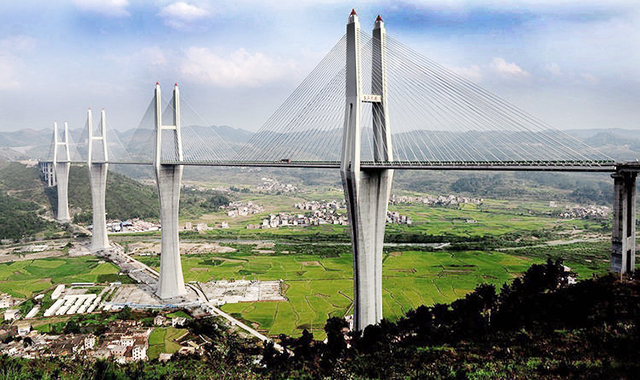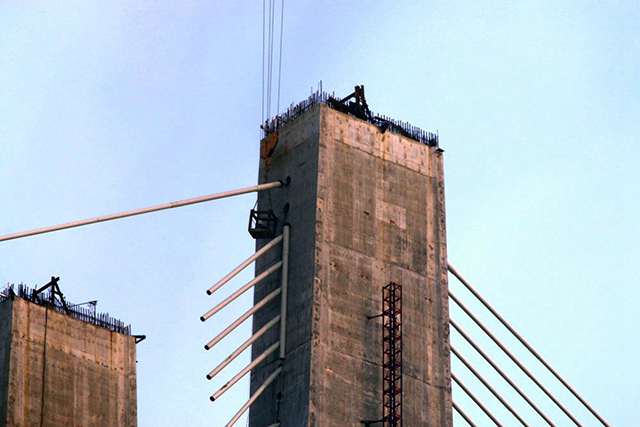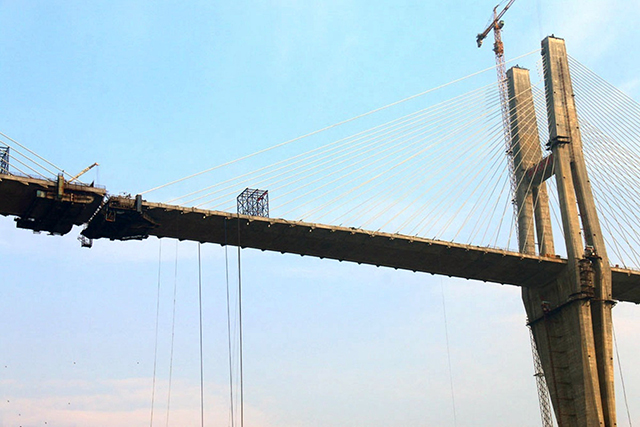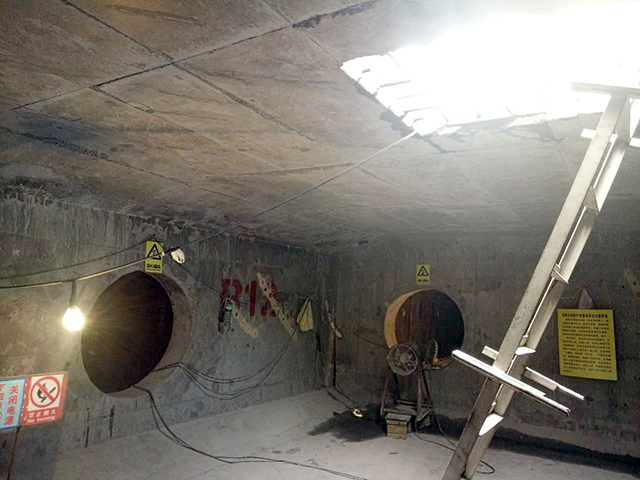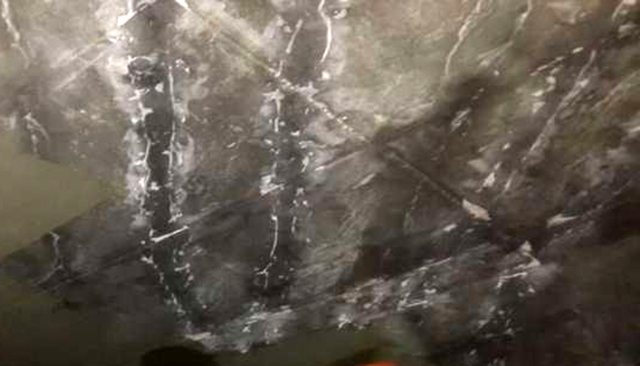Back to Search Results
Bridges
Chishi Bridge
Yizhang County,
China
Xypex applications thus began in April of 2016, with Xypex Concentrate being applied within the interior of the affected box girder, areas of the bridge deck, Pylon P6 and various related concrete components. Through strict process management and control during the treatment of approximately 10,000 square meters of internal and external surfaces, the application of Xypex proved a complete success, ensuring the ‘healing’ of a residual of cracks as well as the restoration of integrity and durability throughout the stress-impacted concretes.
Project Sheet
Project Sheet
PDF
The 2,270 metres long, Chishi Bridge is a cable-stayed bridge carrying the G76 Xiamen-Chengdu Expressway, soaring over 185 meters above the lush valley and township of Chishi, in Yizhang County, Hunan Province, China. When finally opened in October 2016, the Chishi Bridge had set quite a number of “world’s first” records, including the largest bridge span of 380 m.
The bridge was in latter stages of completion when, on October 29th 2014, an accidental fire occurred during welding operations in the hollow pylon tower P6S (south) anchorage area, resulting in nine of the twenty three suspension cables emerging from the west side of the pylon, being totally compromised during the approx. 85 minute fire event.
After the accident and as a result of failure of the nine cables, the west cantilever end of the girder – the same side that had been supported by the ruptured cables – moved downwards by 2.08 meters while at the other side, it moved 0.84 m downwards. Because of the urgency of the situation, engineers first installed and then ‘jacked’ nine temporary cables to stabilise the bridge girder then to return it as close as possible to its original, pre-fire position.
The investigation of the impact of the fire as well as the development of a recovery and restoration plan for the Chishi Bridge was an extremely complicated matter, taking more than a full year and requiring the attention of some of China’s top scientific research institutions, engineering panels and expert technicians.
After carefully investigating every aspect of the damage and structural impact of the fire, the teams then began the search for solutions for restoring an enduring integrity to the structure.
Considering the critical nature of the project, the project teams were necessarily extremely careful in their evaluation of those systems and materials being proposed for the restoration works.
When the final proposals were agreed upon, the damaged concrete components were to be repaired using an amalgam of a very few select technologies, all of which had been exposed to extensive investigation, comprehensive trials, product comparisons, as well as on-site testing and evaluation. The technologies finally chosen included pressure grouting, specialised surface coatings and Xypex penetrating crystalline material, Xypex Concentrate.
In his report (1) Yu Zhang et al noted: The results from the field inspection and simulation showed that (1) the obvious change in cable tension and concrete cracking occurred in only the remaining cables and part of the girder within and around the cable loss area; (2) the loss of nine cables in the local area caused the combined action of torsion and biaxial bending in the girder, and resulted in dense distribution of diagonal cracks in the top slab and box girder webs. Additionally, the damaged bridge recovered very well when the temporary cables that were added to replace the broken cables were jacked to the original design tension.
Xypex applications thus began in April of 2016, with Xypex Concentrate being applied within the interior of the affected box girder, areas of the bridge deck, Pylon P6 and various related concrete components. Through strict process management and control during the treatment of approximately 10,000 square meters of internal and external surfaces, the application of Xypex proved a complete success, ensuring the ‘healing’ of a residual of cracks as well as the restoration of integrity and durability throughout the stress-impacted concretes.
The unremitting efforts of the project department and its many related units resulted in the completely successful restoration of the Chishi Bridge, which was formally opened to traffic on 28th October, 2016.
Reference:
(1) Yu Zhang; Zhi Fang; Ruinan Jiang M.ASCE; Haibin Long; Jiangbo Lu: Static Performance of a Long-Span Concrete Cable-Stayed bridge subjected to Multiple-Cable Loss during Construction. Journal of Bridge Engineering / Vol. 25 Issue 3. Mar. 2020
The bridge was in latter stages of completion when, on October 29th 2014, an accidental fire occurred during welding operations in the hollow pylon tower P6S (south) anchorage area, resulting in nine of the twenty three suspension cables emerging from the west side of the pylon, being totally compromised during the approx. 85 minute fire event.
After the accident and as a result of failure of the nine cables, the west cantilever end of the girder – the same side that had been supported by the ruptured cables – moved downwards by 2.08 meters while at the other side, it moved 0.84 m downwards. Because of the urgency of the situation, engineers first installed and then ‘jacked’ nine temporary cables to stabilise the bridge girder then to return it as close as possible to its original, pre-fire position.
The investigation of the impact of the fire as well as the development of a recovery and restoration plan for the Chishi Bridge was an extremely complicated matter, taking more than a full year and requiring the attention of some of China’s top scientific research institutions, engineering panels and expert technicians.
After carefully investigating every aspect of the damage and structural impact of the fire, the teams then began the search for solutions for restoring an enduring integrity to the structure.
Considering the critical nature of the project, the project teams were necessarily extremely careful in their evaluation of those systems and materials being proposed for the restoration works.
When the final proposals were agreed upon, the damaged concrete components were to be repaired using an amalgam of a very few select technologies, all of which had been exposed to extensive investigation, comprehensive trials, product comparisons, as well as on-site testing and evaluation. The technologies finally chosen included pressure grouting, specialised surface coatings and Xypex penetrating crystalline material, Xypex Concentrate.
In his report (1) Yu Zhang et al noted: The results from the field inspection and simulation showed that (1) the obvious change in cable tension and concrete cracking occurred in only the remaining cables and part of the girder within and around the cable loss area; (2) the loss of nine cables in the local area caused the combined action of torsion and biaxial bending in the girder, and resulted in dense distribution of diagonal cracks in the top slab and box girder webs. Additionally, the damaged bridge recovered very well when the temporary cables that were added to replace the broken cables were jacked to the original design tension.
Xypex applications thus began in April of 2016, with Xypex Concentrate being applied within the interior of the affected box girder, areas of the bridge deck, Pylon P6 and various related concrete components. Through strict process management and control during the treatment of approximately 10,000 square meters of internal and external surfaces, the application of Xypex proved a complete success, ensuring the ‘healing’ of a residual of cracks as well as the restoration of integrity and durability throughout the stress-impacted concretes.
The unremitting efforts of the project department and its many related units resulted in the completely successful restoration of the Chishi Bridge, which was formally opened to traffic on 28th October, 2016.
Reference:
(1) Yu Zhang; Zhi Fang; Ruinan Jiang M.ASCE; Haibin Long; Jiangbo Lu: Static Performance of a Long-Span Concrete Cable-Stayed bridge subjected to Multiple-Cable Loss during Construction. Journal of Bridge Engineering / Vol. 25 Issue 3. Mar. 2020
